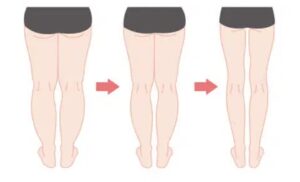Some trends, despite the passage of time, go on sticking with us. This is the case with the “thigh gap,” that aspired to space between the thighs when standing. But why does this anatomical detail continue to captivate… when it’s unreachable the vast majority of us? Here’s a little hint: it’s neither a question of exercise nor willpower.
The thigh gap: a misconception that stands the test of common sense

Since the growth of social media, certain aesthetic standards have taken on overstated
proportions. The thigh gap is sadly one of them. Considered as the ultimate symbol of thinness, it still charges thousands of content on TikTok and Instagram today. Between dubious challenges and “tips” to accomplish it, the message is clear: it would be possible – and even desirable for some – to attain a gap between your thighs . Really?
In reality, the shape of your legs, and this possible gap, relies essentially on factors that are completely beyond your control. We’re speaking about pure anatomy here: pelvic width, femur orientation, muscle structure… In short, elements that have nothing to do with the quality of your diet or your motivation to do squats!
What Science Says (and Your Skeleton)
You probably won’t ever have this gap, even if you’re extremely thin. And that’s quite typical. According to British expert Dr. Ross Perry, this well-known thigh gap is just the outcome of a certain bone arrangement. It’s not a health indication or a fitness objective.
No amount of diet or exercise can alter the fact that your legs are somewhat bent inward or that your pelvic bones are naturally close together. Indeed, this indentation may not be present in models we like in magazines or on catwalks, unless they have undergone photo retouching.
When social pressure becomes unhealthy
What’s most concerning about all of this? Some young women—and younger ones in particular—are being pushed to act dangerously by this illusion. Loss of confidence, excessive exercise, and dietary restrictions are all attempts to meet a standard that is frequently just impossible to achieve.
Nevertheless, there is no one paradigm that our bodies must follow. The richness of bodily variation lies in the fact that every body shape is unique. Many voices today are attempting to remind us of this fundamental truth, which social media occasionally ignores.
What you can do instead
What should you do, then, if you feel that this kind of tendency is influencing you? One word sums it up: refocus. Put your focus back on objectives that will actually help you, like being fitter, stronger, and more flexible. Develop a more calm self-image and learn to respect and listen to your body.
Because there isn’t a legitimate or healthful way to get a thigh gap. So-called “specific” exercises for the inner thighs don’t affect your bone structure, and you can’t “choose” where you want to reduce mass. Learning to embrace your body in its most genuine shape is more essential than altering it to fit a certain image.





